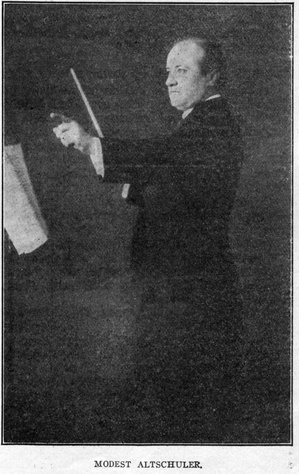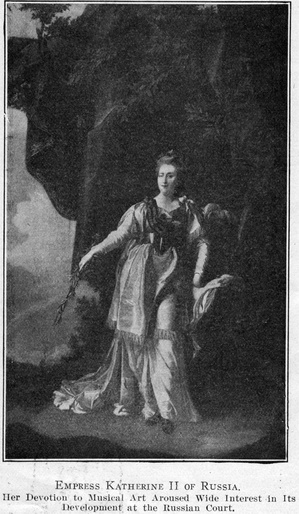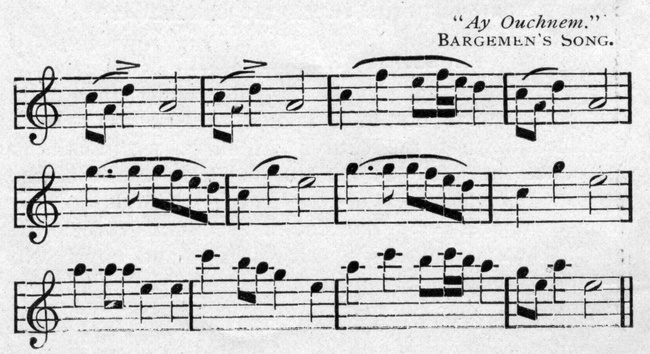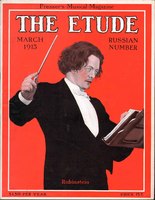
[Editor’s Note.—The rising interest in Russian music in America was perhaps first stimulated by Theodore Thomas, whose service to America became doubly great because of his breadth of vision and initiative in producing works of the moulders of musical thought in all parts of the old world. When Tschaikowsky attended the opening ceremonies in 1891 even many advanced musicians knew little of music in Russia outside of that of Glinka, Rubinstein and Tschaikowsky. It remained for Modest Altschuler to bring the lesser known works of the great modern masters of the Czar’s empire to the attention of Americans. Mr. Altschuler was born at Mogileff, near Kieff, in southern Russia, February 18, 1873. His father was a professional musician who was noted for his ability as an organizer of important concerts. Like most children who become professional musicians the son developed a remarkable liking for music before he was ten years old, and decided to become a virtuoso ‘cellist. Among his teachers were Alfred von Glehn, Fitzenhagen, Arensky and Taneiev.
After leaving the conservatory at Moscow, Altschuler formed a trio for the purpose of reviving many of the forgotten masterpieces written in trio form by great masters. With this combination he toured Europe with much success.
In 1896 Mr. Altschuler came to America and laid the plans for the formation of his orchestra which has been heard in all parts of the United States, and which has ben highly praised by able critics.]
 FOLK MUSIC IN “ALL THE RUSSIAS.”
FOLK MUSIC IN “ALL THE RUSSIAS.”
It is difficult for one who has not recently investigated a map of the Russian Empire to comprehend the vastness of the great territory it covers, to perceive how this territory is broken by rivers and mountain passages, dreary steppes and other natural divisions which, with limited facilities for transportation, have kept the different parts of Russia separated in such a manner that the great number of folks of which the country is composed have been enabled to preserve their original local and racial integrity in an astonishing manner. Why “all the Russias?” Because Russia is a composite of many different races, each with its own peculiar customs, traditions and folk music. It is to these people that the modern composers of Russia have gone for their inspiration. Possibly no musical masterpieces of any other nation are so strongly impregnated with the blood, fiber and soul of the people as those of the Russians who have struggled so valiantly to preserve the original and beautiful folksongs of the races of “All the Russias.”
In thinking of Russian music as a national music we must realize at once that the music which developed in the Russian Imperial Court, while of immense value to the progress of the country, was of a totally different nature from that of the people. The opulent nature of the Imperial and Grand Ducal entertainments in Russia has been world-renowned. Artists from all the lands of culture have been surprised by the lavishing of the court functions. In addition to this the ambassadors desiring to win imperial favor have brought the greatest artists from their home lands to entertain the nobility. Since the fourteenth century musicians, painters, and actors of all countries have frequently gone to Russia through diplomatic persuasion. At first came the Italians, then the Germans and the French, each in turn making an impress upon the taste of the cultured people of the great cities.
However, between these people and the peasant class, where the latent musical greatness of Russia still resided, there was a chasm vast, deep and terrible. The peasants were at that time little different from the slaves in America. The position of the serf was often filled with oppression, and it was not until the reign of Alexander II that those down-trodden white men were removed from their slavery. What appears as a very tardy development in the great nation was really the evolution of traditions so deeply embedded in the people themselves that more rapid progress might have been impossible. Russia as a nation dates from the year 988, and owes much to the Greek church for its amalgamation as a single land. Consequently, we encounter a third element in the musical expansion of the country—the music of the church. The church at times did not take kindly to the crude music of the people, and even took away their primitive instruments and burned them in huge bonfires. But one can not take away what the people really want when it is right for them to have it, and the people reconstructed their instruments quite as rapidly as they had been taken from them. Indeed, to this day many of the oldest peasant instruments upon the European continent may be found in Russia.
America has only recently been made acquainted with the Balalaika. This instrument partakes of the character of both the guitar and the mandolin and yet has a quality quite its own. When well played, as in the orchestra of Andrerelb, which has visited this country, some exquisite effects are obtainable.
RUSSIAN CHURCH MUSIC.
Prior to the appearance of Christianity in Russia the people were not even known as Russians. With the incoming of the church an effort was made to introduce the music of the church as the music of the people. The services of the Russian church are extremely impressive. The choirs are often very large, and are composed exclusively of men and boys. No organs, in fact, no instruments of any kind are permitted in the churches. The result has been exceptionally fine choral music. The people, however refused to accept the music of the church in the place of that which they had themselves created. This was despite the fact that the priests are also singers and often have commanding voices.
MUSIC AT THE RUSSIAN COURT.
While the peculiar character of modern Russian music owes much to the native folk material out of which it has been largely built, we must not minimize the great service of the pleasure loving monarchs who did so much to foster the development of the art in the lands under their dominion. Even as far back as the reign of Ivan III (1462), who liked to play the violin, music at the Russian court was an important function. Ivan the Terrible (1533), the three famous Emperors who bore the name of Peter (1672, 1715, 1728), the Empress Ioanovna (1693), Elizabeth (1709), reigned at the time when the art in Western Europe was developing the conditions which led to the masterpieces of Bach and Handel. Katherine II (1729), Pavel (1754), Alexander I (1777), and the rulers of the succeeding centuries have all contributed their share toward the promotion of music. Naturally, the nobles followed in their lead, and we meet such famous art patrons as Razumovsky and his contemporaries. Beethoven, it will be remembered, dedicated three quartets to Count Razumovsky.
Notwithstanding all this imperial support it should be remembered that it was directed toward music of other nations, first Italian music and then German music. Thus, the music of Russia that deserves to be called Russian music—music breathing the spirit of the people—is really very new; some declare it to be only seventy-five years old. That is, it was not until this comparatively recent period that the composers of ability commenced to adapt the native tone material to their needs in producing great masterpieces.
 OUTLINE OF RUSSIAN MUSICAL PROGRESS.
OUTLINE OF RUSSIAN MUSICAL PROGRESS.
With the view of securing a more definite outline of the development of music in Russia, its history may be divided into four periods or epochs. The first period, within its limits, was purely national. It included all the most ancient folk-songs and Biulenas, or metrical legends. It saw the rise and fame of the skomorokh, or minstrels, the composers and preservers of these epics and songs. These minstrels were of two classes: Singers (birds), and gusslee-players (harpists), like the celebrated skald, Bayan; and jesters, some of whom were wanderers, and others attached to the service of the nobility. This period reached its highest development in the reign of Vladimir, “the glorious Son,” first Christian prince of Russia, about 988 A. D.
The Second Period, which was one of decadence, dates from the establishment of Christianity in Russia, at the close of the tenth century, when folk music lost much of its independence and fell under Byzantine influence. The Greek Church was strenuously opposed to every form of secular art, especially as the folksongs were of pagan origin. Therefore, just as the local ecclesiastical authorities look askance at the songs and legends of the Brittany peasants, which perpetuate the memory of heathen customs, so the Byzantine monks of the eleventh century condemned the national songs of Russia as being opposed to the spirit of Christianity.
Thus, the primitive music had little chance of development. Driven from the centres of dawning civilization, it took refuge in forest settlements and remote villages. With it fled the bards, the companies of gleemen, or “merry youths,” as the Russians call them, so dear to the hearts of the people. But the monkish persecution could not entirely stamp out the love of music from the land. To do this it would have been necessary to obliterate the very soul of the nation. So long as the minstrel remained, the old songs were not in danger of becoming extinct. Despite the fulminations of the clergy, the nobles still secretly patronized and cherished their singers, and beguiled the tedium of life by frequenting their “halls of entertainment,” or in Russian, Poteshni palate. In time, however, the ascetic and intolerant teaching of the monks altered the temper of the people and weaned them away from religious superstition. The power of the minstrels declined. They ceased to be “welcome guests” in cottage and hall; they degenerated into companies of roving thieves, driven from place to place by their clerical persecutors.
By way of compromise, the “gleemen” invented that curious class of song called “spiritual,” or “sacred,” in which pagan and Christian sentiments were mixed in an incomprehensible jumble. The musical disposition of the people suffered, and their creative faculties stagnated. This state of things continued until the reign of Alexis Mikhailovitch (1645-76). Alexis was exceedingly fond of music, and summoned several German musicians to his court, who taught the Russians the use of many instruments hitherto unknown to them. This action provoked the last and most violent outburst of clerical intolerance. In 1649, by order of the patriarch Joseph, all the musical instruments in Moscow, except those belonging to the Emperor’s German musicians, were confiscated and burned in the open market-place. Towards the end of the reign, however, this fanaticism seems to have worn itself out. The voice of the people was once more raised in song, and there appeared to be a fair possibility of musical progress.
The advent of Peter the Great did little for the development of national music. The fine arts made no appeal to the utilitarian mind of this monarch. Music ceased to be regarded as one of the seven deadly sins, but suffered a worse fate, since in the inrush of novel, cosmopolitan ideas, the national songs were completely forgotten for a time. During this reign, however, some of the enlightened nobles began to keep private bands in imitation of those they had seen in the courts of foreign princes.
The Third Period of Russian music commenced at the close of the seventeenth century. The national music now regained some of its former importance.
Its progress was checked, because the influence of Western Europe was already paramount in Russia. Italian music had reached the capital and long held the field.
The first twenty years of the last century witnessed a strong revival of genuine interest in the folk-music so that when in 1836 Glinka composed his opera, A Life for the Czar, he inaugurated the Fourth Period in the history of the national tone-art of Russia.
THE DEVELOPMENT OF NATIVE MATERIAL.
The Russian peasants, and those who are only a few generations away from serfdom, are for the most part a simple-hearted, elementary class of people who toil tremendously, have few pleasures and little time of their own. Nevertheless, they are a very musical people, and it is quite impossible for one who has not lived among them to realize how indissoluble is the bond between them and their music. It is as much a part of their lives as their skin, their hair or their teeth. Life without music is unthinkable to them. We shall learn later how peculiarly close this tone bond really is.
Back hundreds of years the music was provided for the people by the public entertainers known as skomorokh. The skomorokh was part clown, part minstrel, part jester. His songs were usually banal as well as humorous, but he incited the people to make music of their own; music and songs that quite naturally met the disapproval of the priests in due turn. Centuries of depression naturally made its mark upon the minds of the people. Under the yoke one is not expected to sing songs of mirth. The melancholy minor nature of many of the folk-songs adds to their individuality, and again to their grandeur when developed under the master hand of Glinka, Tschaikowsky, Rimsky-Korsakoff or Glazounoff.
THE GREAT ANTIQUITY OF RUSSIAN FOLK MUSIC
It is frequently claimed that the folk music of Russia is the oldest in Europe. It is not difficult to believe that the people of other countries may not have been able to preserve their folk melodies as have the Russians for the simple reason that the Russian people remained in a more primitive state until very recent decades. Old French, German and English melodies have been preserved in libraries, but the Russians actually employed them in their daily life just as they were sung perhaps a thousand years ago. Each section of Russia has its own folk songs. The Russian government has recently participated in the search for these songs, and no less than ten large books have been made from the collected material. Since the peasants are advancing every day these songs stand a chance of becoming extinct.
The songs are made an integral part of life in all manner of manifestations. For instance, every trade has its own characteristic song, and these songs are sung with a peculiar rhythm and nuance that is impossible to indicate upon paper. Take such a song as the Bargemen’s Song, which I have often introduced in my concerts in the form orchestrated by Glazounoff (unpublished). The bargemen on the great river Volga are human beasts of burden who drag the barges along the river by means of ropes fastened over the shoulders much as horses and mules in America pull along the canal boats. As they trudge ahead they have a peculiar song, and at certain places in this song they emphasize every movement by means of accents indicating a special strain. The Bargemen’s Song runs as follows. At the places marked special stress is laid to indicate the output of more force in tugging the boat along:
(A second section of Mr. Altschuler’s exceptionally interesting discussion of Russian Folk Music will appear in The Etude for April.)




